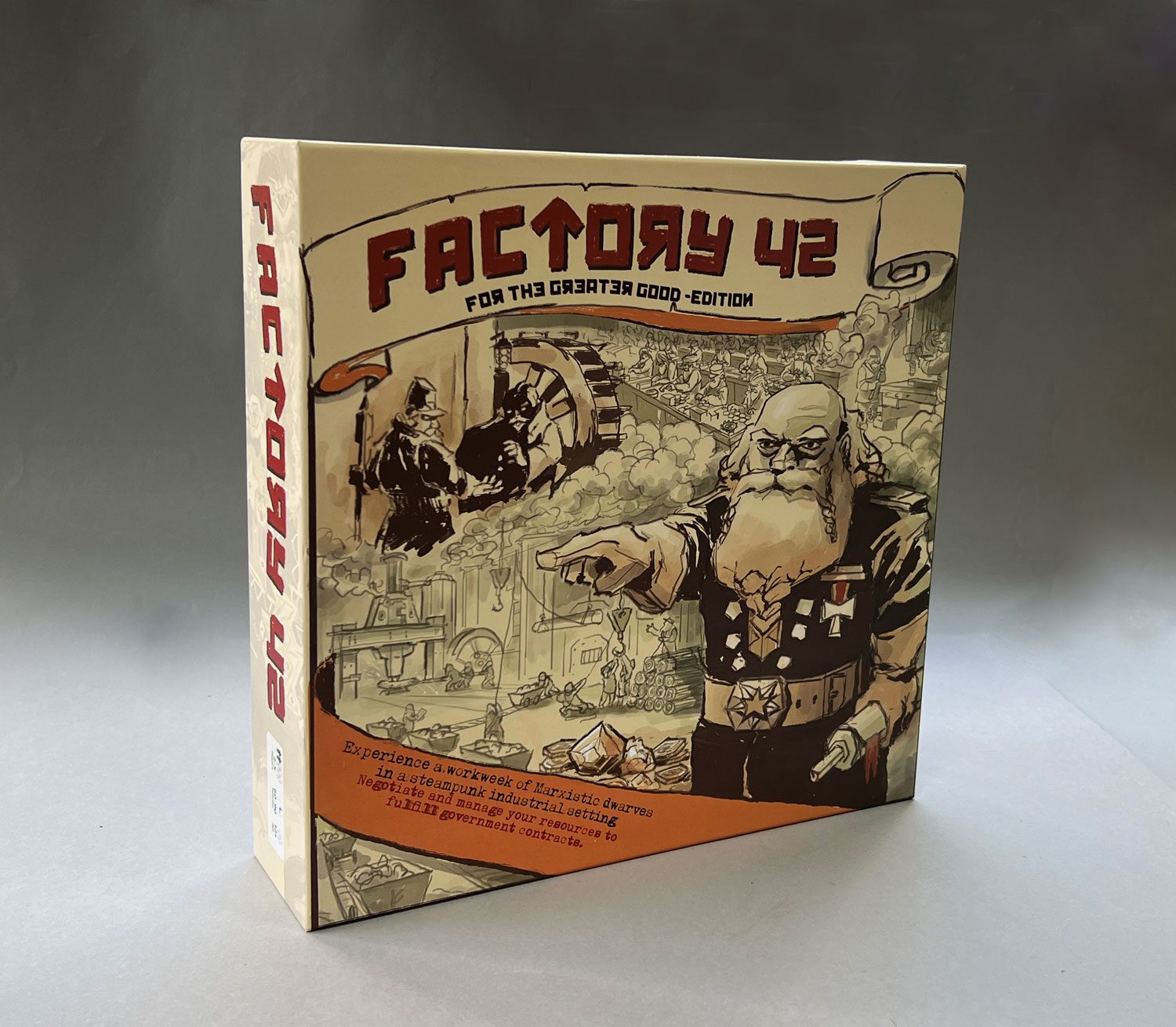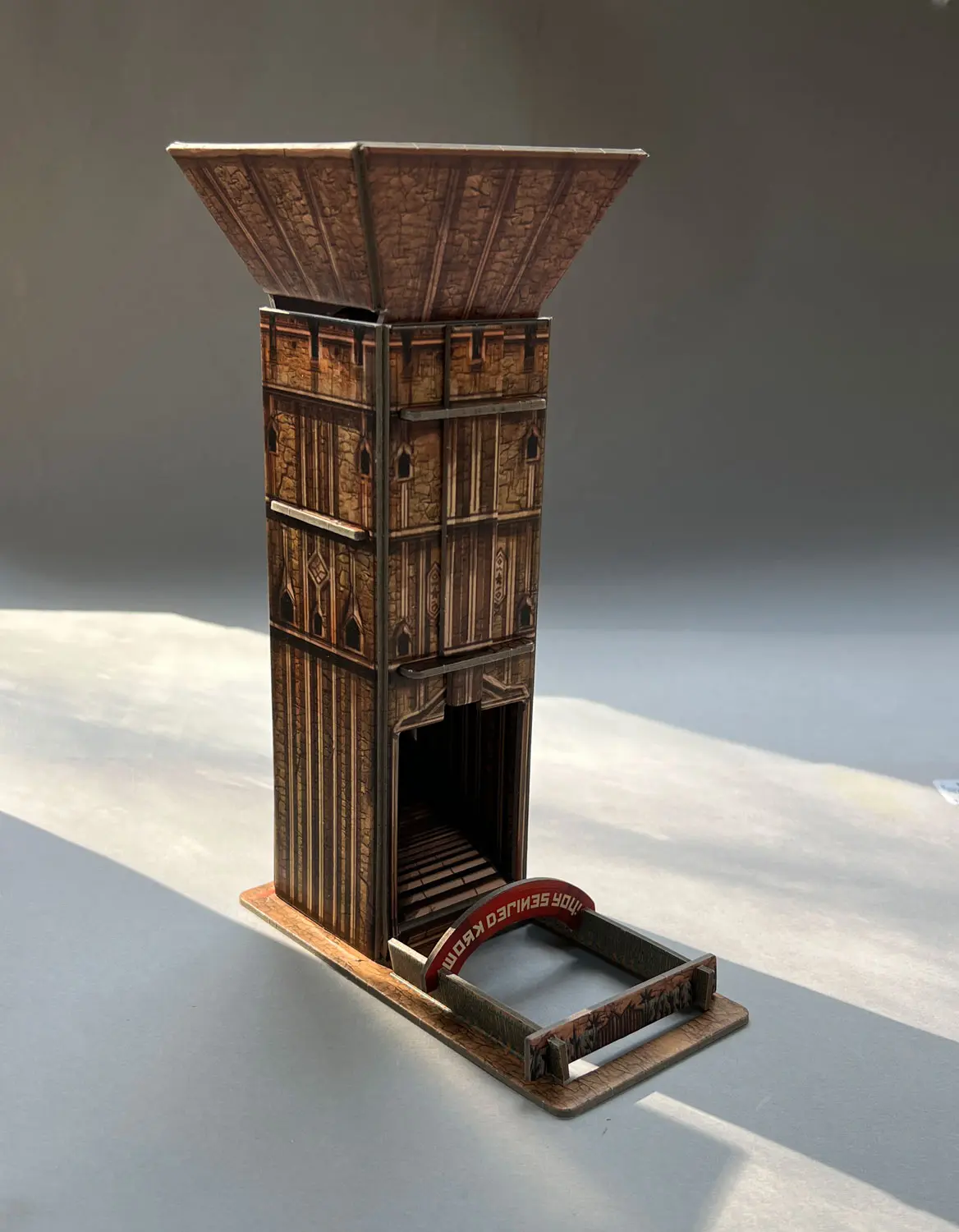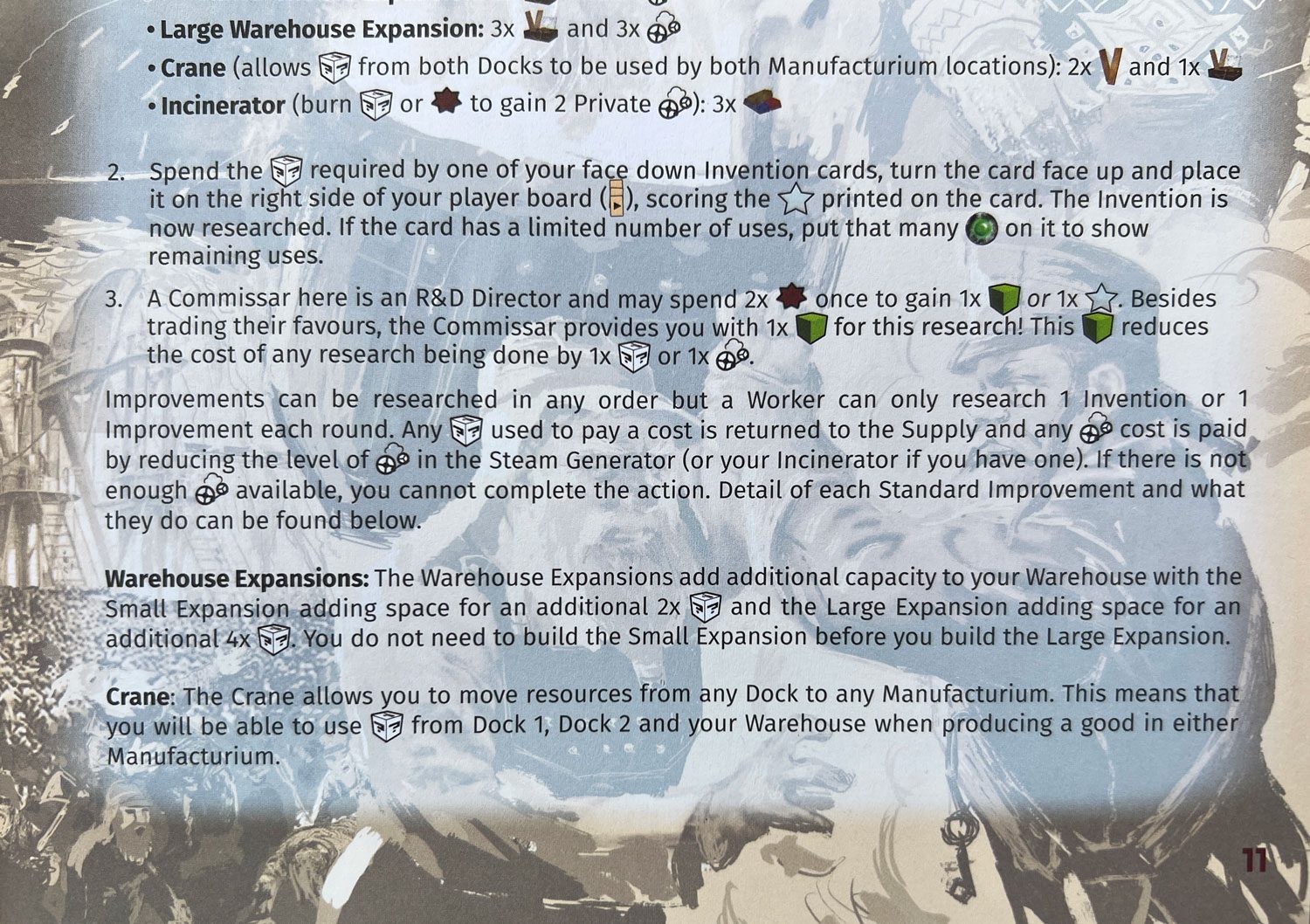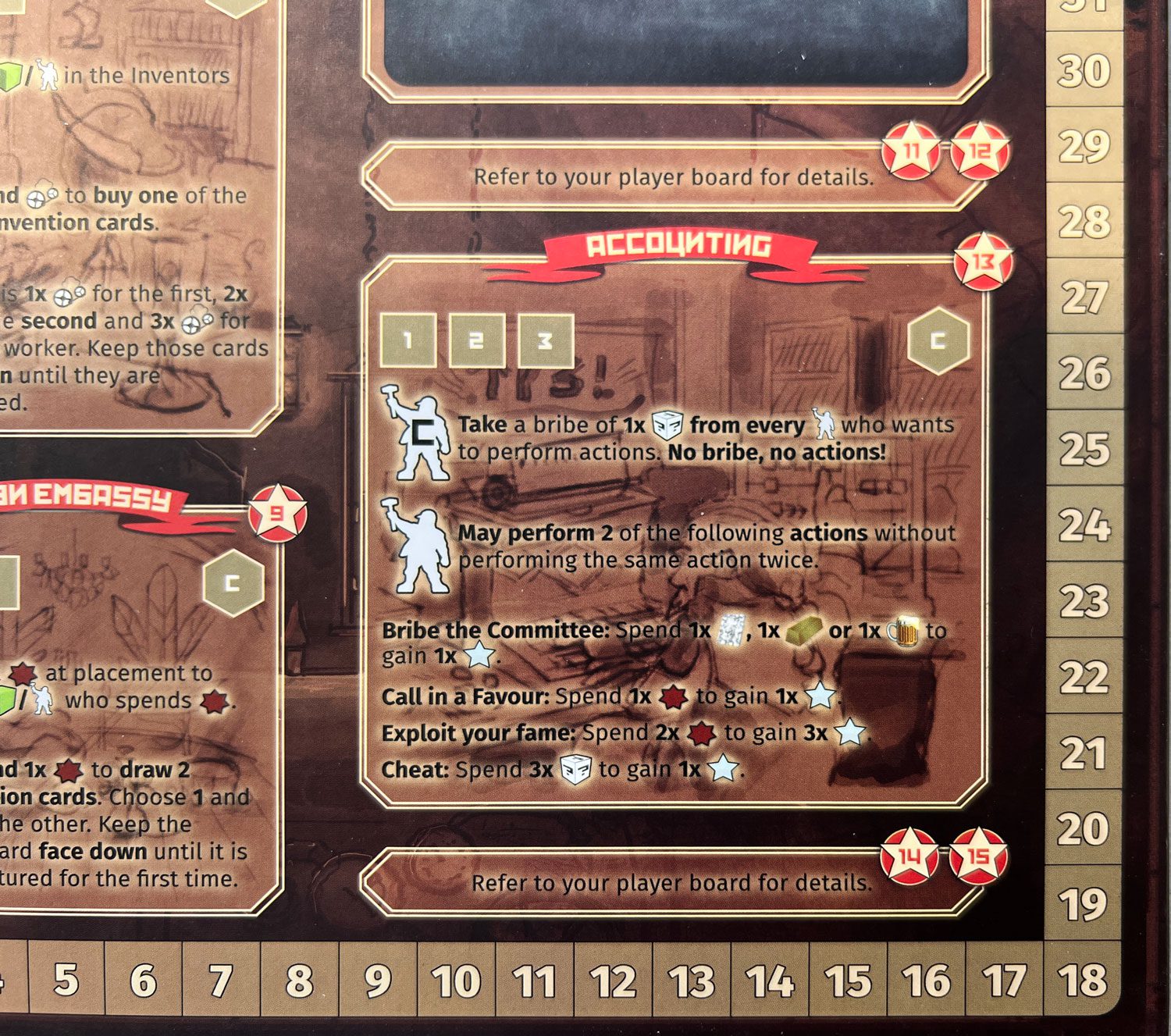Disclosure: Meeple Mountain received a free copy of this product in exchange for an honest, unbiased review. This review is not intended to be an endorsement.
In Factory 42 you’ll play as a Dwarven Overseer, working in some kind of Steampunk-ish Soviet-era mines. Don’t think too hard about it because, to be honest, it really doesn’t matter. This is a straight-forward worker placement game, albeit one with an extra mechanic that is worth looking at.
Since important areas of the game run into pseudo-Soviet-era Bureaucracy, let’s take a point-by-point look at the game.

The Bureaucratic Run Down
- You win by having the most points at the end of the game.
- You gain points by acquiring rosettes and taking actions to convert them into points.
- You get rosettes by completing Government Contracts and through certain actions.
- You complete Government Contracts by having mining carts containing resources shipped to you.

- You get those resources by Requisitioning them, then adding them to the common pool of resources.
- However, the Common Pool of resources must first go through the Tower of Bureaucracy. Some resources will pass through, while others will get stuck in bureaucratic red tape and not be available.

- You’ll take actions to load mine carts up with the available resources. Another action is required to ship those carts to player boards.
- All remaining, flammable resources are burned to produce the steam required to fulfill a Contract.
- Another action is required to use the resources on your player board to fulfill a Contract.
- At the end of a round, any Government Contract not completed will cost everyone either one point or two rosettes.
The Additional Bits
Those are the basics of the game. You’ll have six or seven workers (depending on player count) that you’ll place, one worker per player at a time, until they’ve all been placed. You’ll use most of them to do the things that will help the group collect resources (while gaining some for yourself) and to take the actions that will allow you to score points.
You’ll have the option to increase your ability to store additional resources from round to round, as well as improving your use of the two mining carts you’ll likely end up with on your player board.
If you’re familiar with worker placement games, you’ll get what’s going on here.
There is, however, one twist that makes Factory 42 worth examining.
What, Exactly, IS a Semi-Cooperative?
Factory 42 is billed as a semi-cooperative game. That means, within the game, it benefits everyone to work together to make sure all the Government Contracts are fulfilled in each round. (Remember, for each Contract not fulfilled, all players lose one point or two Rosettes) This will mean that discussions, along with some negotiations, are often a necessary part of the game. From agreeing on what resources to Requisition to the Common Pool, to having someone load and/or ship, there’s too much going on to do it all yourself.
However, there can only be one winner. This means Factory 42 is a cooperative game until it isn’t.
If someone is pulling into the lead, the other players can work together to send them unhelpful resources. Have points/Rosettes to spare? Maybe you’ll go for one of those upgrades instead of fulfilling a Contract—that way you can store enough resources to not have to depend on the whims of those delivering mining carts.
This tension has the potential to create some fascinating dynamics.
With a New Mechanic, What’s Not to Like?
For the first time with any review copy, I started making notes of things that were bothering me when I first unboxed Factory 42 to give it a test play. Why, for instance, place a single cardboard punch out board on top of the insert but hide all the others underneath it? Why was there only one player aid that lists the relative purchase/burning points of the resources in the game? And where is something, anything, that tells me how to set up all the parts of the game?
And then there’s the rule book. When my Meeple Mountain colleague and board game designer Gary Chavez wrote his excellent article on Rule Book design, he could have used Factory 42’s rule book as a How Not to example.
There are two things you’ll notice when you open the rule book. First, each page has a prominent background image of Soviet-era Dwarven Overseers that often makes reading the text difficult. On top of that, icons are substituted for the names of resources throughout. Worse, there were icons for collections of specific resources that I could not find defined anywhere except on the board for those resources.

(I wondered why this horrible design seemed familiar. Then I learned that the publisher, Dragon Dawn Productions, had also released Perdition’s Mouth: Abyssal Rift, a game I reviewed in 2022. Perdition’s Mouth also used even darker, distracting background images and substituted icons for text throughout the very long rule book.)
Unfortunately, this text-over-graphics concept is carried over to the game and player boards as well.

Factory 42’s overall design emphasizes complexity over fun. Our first game was a slog. The board consists of shades of brown with black text over black illustrations. We strained to read each area’s text (through the background graphics) when we placed workers and, again, when we resolved the actions. In our second game, we were able to go through the 11 Action areas quickly, but reading any of the text from across a table wasn’t possible.
The Tower of Bureaucracy is a cardboard dice tower with three layers of interference (cardboard squares with odd shapes missing) that is supposed to capture some of the resources you pour into it. Except, it rarely does so. The tower itself rests on a cardboard stand that, after only three plays, tore at both sides of the base. If set up as shown in the instructions, there’s no easy way to physically collect all the cubes that fall out in the bottom area without knocking against the tower.
There is a ‘fence’ at the base of the stand to keep all the cubes in the enclosed area. However, every time we used the Tower, cubes bounced all over the table.
Final Thoughts
Despite all these negatives, I really wanted to like Factory 42. I liked the ideas behind many of the actions, including having to take a specific action in order to convert Rosettes into points. I especially liked the idea of the semi-cooperative mechanic.
However, Factory 42 failed us on so many levels, particularly where the semi-cooperative part was supposed to come in. In our last game, having figured out our strategies for the game, there was barely a hint of cooperation around the table. Loading and delivering mining carts was a cutthroat business. Then, we ran out of Rosettes, giving us no incentive to accomplish anything in the game. Points would suffer, but they’d suffer equally for everyone.
One of my gaming group is very easy-going and rarely speaks negatively about any game we play. After our first playthrough of Factory 42, without being asked, gave this summation:
“This is a lot like other games we’ve played. If I’d have bought this game, I would have played it twice, been disappointed that I’d bought it, and left it in a corner.”
I can’t argue with that. In fact, Factory 42 is now taking a place in a far corner of my collection, waiting for the chance to find another home.












Add Comment